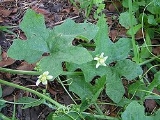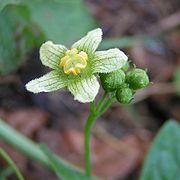
Bryony
Encyclopedia
Bryonia is a genus of flowering plant
in the cucumber family
. Bryony (icon) is its most well-known common name. They are native to western Eurasia
and adjacent regions, such as North Africa
, the Canary Islands
and South Asia
.

, tendril-climbing
, diclinous or dioecious
herb
s with palmately lobed leaves and flower
s in axillary clusters. The fruit
is a smooth, globular berry
.
The only English
species, B. dioica
(White Bryony), grows in hedgerows as far north as Yorkshire
.
Bryonia is used as a food plant by the larva
e of some Lepidoptera
(butterflies and moth
s), including the tortrix moth Phtheochroa rugosana
(recorded on Red Bryony, B. dioica
) and the Cabbage Moth
(Mamestra brassicae).
ous, some highly so, and may be fatal if ingested.
Variants of the plants' name, such as Briony, Bryonie and Bryony, are used in some cultures as female given name
s. They were quite popular in the 18th century.
The Royal Navy
named two ships HMS Bryony
after the plant.
are presently accepted by the USDA:
Ten of these are supported in a molecular-phylogenetic analysis:
Flowering plant
The flowering plants , also known as Angiospermae or Magnoliophyta, are the most diverse group of land plants. Angiosperms are seed-producing plants like the gymnosperms and can be distinguished from the gymnosperms by a series of synapomorphies...
in the cucumber family
Cucurbitaceae
The plant family Cucurbitaceae consists of various squashes, melons, and gourds, including crops such as cucumber, pumpkins, luffas, and watermelons...
. Bryony (icon) is its most well-known common name. They are native to western Eurasia
Eurasia
Eurasia is a continent or supercontinent comprising the traditional continents of Europe and Asia ; covering about 52,990,000 km2 or about 10.6% of the Earth's surface located primarily in the eastern and northern hemispheres...
and adjacent regions, such as North Africa
North Africa
North Africa or Northern Africa is the northernmost region of the African continent, linked by the Sahara to Sub-Saharan Africa. Geopolitically, the United Nations definition of Northern Africa includes eight countries or territories; Algeria, Egypt, Libya, Morocco, South Sudan, Sudan, Tunisia, and...
, the Canary Islands
Canary Islands
The Canary Islands , also known as the Canaries , is a Spanish archipelago located just off the northwest coast of mainland Africa, 100 km west of the border between Morocco and the Western Sahara. The Canaries are a Spanish autonomous community and an outermost region of the European Union...
and South Asia
South Asia
South Asia, also known as Southern Asia, is the southern region of the Asian continent, which comprises the sub-Himalayan countries and, for some authorities , also includes the adjoining countries to the west and the east...
.

Description and ecology
Bryonies are perennialPerennial plant
A perennial plant or simply perennial is a plant that lives for more than two years. The term is often used to differentiate a plant from shorter lived annuals and biennials. The term is sometimes misused by commercial gardeners or horticulturalists to describe only herbaceous perennials...
, tendril-climbing
Vine
A vine in the narrowest sense is the grapevine , but more generally it can refer to any plant with a growth habit of trailing or scandent, that is to say climbing, stems or runners...
, diclinous or dioecious
Dioecious
Dioecy is the property of a group of biological organisms that have males and females, but not members that have organs of both sexes at the same time. I.e., those whose individual members can usually produce only one type of gamete; each individual organism is thus distinctly female or male...
herb
Herb
Except in botanical usage, an herb is "any plant with leaves, seeds, or flowers used for flavoring, food, medicine, or perfume" or "a part of such a plant as used in cooking"...
s with palmately lobed leaves and flower
Flower
A flower, sometimes known as a bloom or blossom, is the reproductive structure found in flowering plants . The biological function of a flower is to effect reproduction, usually by providing a mechanism for the union of sperm with eggs...
s in axillary clusters. The fruit
Fruit
In broad terms, a fruit is a structure of a plant that contains its seeds.The term has different meanings dependent on context. In non-technical usage, such as food preparation, fruit normally means the fleshy seed-associated structures of certain plants that are sweet and edible in the raw state,...
is a smooth, globular berry
Berry
The botanical definition of a berry is a fleshy fruit produced from a single ovary. Grapes are an example. The berry is the most common type of fleshy fruit in which the entire ovary wall ripens into an edible pericarp. They may have one or more carpels with a thin covering and fleshy interiors....
.
The only English
England
England is a country that is part of the United Kingdom. It shares land borders with Scotland to the north and Wales to the west; the Irish Sea is to the north west, the Celtic Sea to the south west, with the North Sea to the east and the English Channel to the south separating it from continental...
species, B. dioica
Bryonia dioica
Bryonia dioica, known by the common names red bryony and white bryony, is a perennial climbing vine indigenous to Central and Southern Europe. It is a flowering plant of the genus Bryonia with five-pointed leaves and blue or white flowers. The vine produces a red berry fruit.-Medicinal use:A...
(White Bryony), grows in hedgerows as far north as Yorkshire
Yorkshire
Yorkshire is a historic county of northern England and the largest in the United Kingdom. Because of its great size in comparison to other English counties, functions have been increasingly undertaken over time by its subdivisions, which have also been subject to periodic reform...
.
Bryonia is used as a food plant by the larva
Larva
A larva is a distinct juvenile form many animals undergo before metamorphosis into adults. Animals with indirect development such as insects, amphibians, or cnidarians typically have a larval phase of their life cycle...
e of some Lepidoptera
Lepidoptera
Lepidoptera is a large order of insects that includes moths and butterflies . It is one of the most widespread and widely recognizable insect orders in the world, encompassing moths and the three superfamilies of butterflies, skipper butterflies, and moth-butterflies...
(butterflies and moth
Moth
A moth is an insect closely related to the butterfly, both being of the order Lepidoptera. Moths form the majority of this order; there are thought to be 150,000 to 250,000 different species of moth , with thousands of species yet to be described...
s), including the tortrix moth Phtheochroa rugosana
Phtheochroa rugosana
Phtheochroa rugosana is a small moth of the family Tortricidae.It is found in western Europe east to the Benelux, Switzerland and Italy, and further across the Balkans and Hungary to Asia Minor and Armenia. It also occurs in the Maghreb and on the Canary Islands. The wingspan is 18–23 mm...
(recorded on Red Bryony, B. dioica
Bryonia dioica
Bryonia dioica, known by the common names red bryony and white bryony, is a perennial climbing vine indigenous to Central and Southern Europe. It is a flowering plant of the genus Bryonia with five-pointed leaves and blue or white flowers. The vine produces a red berry fruit.-Medicinal use:A...
) and the Cabbage Moth
Cabbage Moth
Note: the Small White species of butterfly is commonly called a "cabbage moth" in North America.The Cabbage Moth is a common European moth of the family Noctuidae....
(Mamestra brassicae).
Use by humans
Bryonies are occasionally grown in gardens, sometimes accidentally, sometimes deliberately so. Some species find use in herbal medicine. Generally however, these plants are poisonPoison
In the context of biology, poisons are substances that can cause disturbances to organisms, usually by chemical reaction or other activity on the molecular scale, when a sufficient quantity is absorbed by an organism....
ous, some highly so, and may be fatal if ingested.
Variants of the plants' name, such as Briony, Bryonie and Bryony, are used in some cultures as female given name
Given name
A given name, in Western contexts often referred to as a first name, is a personal name that specifies and differentiates between members of a group of individuals, especially in a family, all of whose members usually share the same family name...
s. They were quite popular in the 18th century.
The Royal Navy
Royal Navy
The Royal Navy is the naval warfare service branch of the British Armed Forces. Founded in the 16th century, it is the oldest service branch and is known as the Senior Service...
named two ships HMS Bryony
HMS Bryony
Two ships of the Royal Navy have borne the name HMS Bryony, after the flower Bryony:*HMS Bryony was an Anchusa class sloop, launched in 1917 and broken up in 1938....
after the plant.
Species
Twelve speciesSpecies
In biology, a species is one of the basic units of biological classification and a taxonomic rank. A species is often defined as a group of organisms capable of interbreeding and producing fertile offspring. While in many cases this definition is adequate, more precise or differing measures are...
are presently accepted by the USDA:
Ten of these are supported in a molecular-phylogenetic analysis:
- Bryonia acuta Desf. (formerly sometimes included in B. cretica)
- Bryonia alba L. – White BryonyWhite BryonyWhite Bryony is a vigorous vine with major destructive potential to native vegetation, forest communities, vineyards, and farmland...
- Bryonia aspera Steven ex Ledeb.
- Bryonia cretica L. – Cretan Bryony
- Bryonia dioicaBryonia dioicaBryonia dioica, known by the common names red bryony and white bryony, is a perennial climbing vine indigenous to Central and Southern Europe. It is a flowering plant of the genus Bryonia with five-pointed leaves and blue or white flowers. The vine produces a red berry fruit.-Medicinal use:A...
Jacq. – White or Red Bryony (formerly sometimes included in B. cretica) - Bryonia lappifolia Vassilcz.
- Bryonia marmorata E.M.A.Petit
- Bryonia melanocarpa Nabiev
- Bryonia monoica Aitch. & Hemsl.
- Bryonia multiflora Boiss. & Heldr.
- Bryonia syriaca Boiss.
- Bryonia verrucosa Aiton
Formerly placed here
- Many species of Cayaponia ("American bryonies")
- Several species of CucumisCucumisCucumis is a genus of twining, tendril-bearing plants in the Cucurbitaceae family which includes the cucumber, true melons, the horned melon, and Cucumis anguria, the West Indian gherkin...
, Solena and ZehneriaZehneriaZehneria is a genus of flowering plants – of vines in the cucumber and gourd family Cucurbitaceae. It contains about 35 species ranging from Africa, through Southeast Asia to Australia and Oceania. The name honours botanical artist Joseph Zehner.... - Coccinia abyssinica
- Corallocarpus epigaeus
- Diplocyclos palmatusDiplocyclos palmatusDiplocyclos palmatus is a vine native to rainforest and dry rainforest of Australia, Papua New Guinea and Malesia.- Sources :* http://keys.trin.org.au:8080/key-server/data/0e0f0504-0103-430d-8004-060d07080d04/media/Html/taxon/Diplocyclos_palmatus.htm...
- Kedrostis africana
- Melothria pendula (as B. guadalupensis)
- Trichosanthes ovigera (as B. cucumeroides)
See also
- Black BryonyBlack BryonyDioscorea communis is a species of flowering plant in the yam family Dioscoreaceae and is commonly known as Black Bryony.-Description:...
(Dioscorea communis), an unrelated but similar-looking plant of the DioscoreaceaeDioscoreaceaeDioscoreaceae is a family of monocotyledonous flowering plants, with about 750 species in eight or nine genera. The best-known member of the family is the Yam .... - Bryonopsis (meaning "looks like bryony"), a now-invalid genus currently assigned to close (DiplocyclosDiplocyclosDiplocyclos is a genus of climbimg or trailing vine in the family Cucurbitaceae. The genus comprises four or five species. D. palmatus is pantropical in distribution and the remainder of species are restricted to Africa...
) and somewhat more distant (Kedrostis) relatives of Bryonia
External links
- Medicinal uses of Bryonia alba - Note: This is a historical document from the 1930s and may not be medically accurate today.
- Bryonia cretica Flowers in Israel

